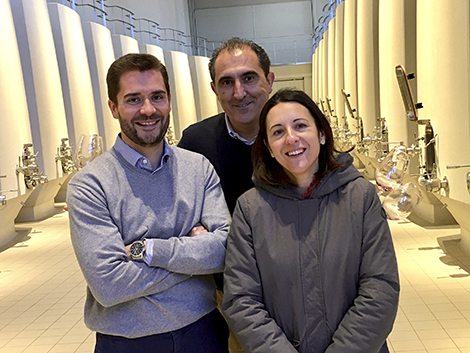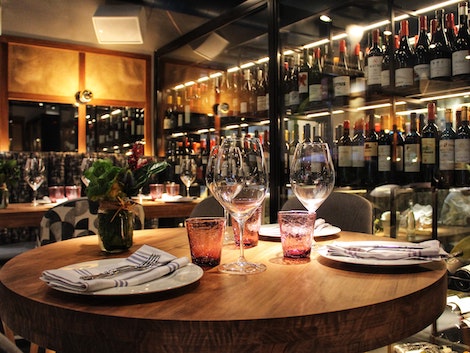Ramón Bilbao moves into the top single-vineyard category in Rioja with Lalomba

At the end of April 2017, I visited the vineyard purchased by Ramón Bilbao three years earlier on the slopes of Mount Yerga, one of the prized areas in Rioja Oriental (then still known as Baja) for its elevation, perfect aeration and near absence of frost. With 160 hectares, 90 of them under vine, the estate was planted from 1970 onwards with massal selections of Tempranillo, Garnacha and some Viura. It was the new "jewel" in the group’s crown and there were big plans for it.
A regular buyer of grapes from this property since 1999, the company was well aware of the floral character and freshness of the Tempranillo grown here. After the purchase, Ramón Bilbao started exploring and mapping the vineyards in order to assess the real potential of each plot. The work included microbiological soil analysis in partnership with specialist company WineSeq and the development of a specific yeast for this area which has become one of the winery's best tools. All the work was coordinated by Rosana Lisa, head of R&D at Ramón Bilbao.
On the way to make a difference
The previous year, part of this potential was revealed with the launch of Lalomba (the name means hill or slope), a premium rosé made with Garnacha and around 10% of Viura that benefited from the fresh conditions of the property. Perhaps the Provençal pale colour and sophisticated packaging were more striking than the wine's elegance and vibrant acidity that made the wine suitable to develop in bottle. In any case, the fancy bottle will disappear in the 2019 vintage.
At the risk that some consumers may long for the screen-printed bottle with the fancy images of Ramón Bilbao's groundbreaking advertising campaign, the wine -set to be released in April- will have a more restrained appearance and will feature the name of the plot where the grapes are sourced: Finca Lalinde.
The reason for this is that, after much in-house discussion, the idea of Lalomba being a single-vineyard set of wines from Mount Yerga has been dropped in favour of a collection of special vineyards found across the appellation like those in Villalba and San Asensio in Rioja Alta.
“Vineyards with singular profiles have been fermented and aged separately. If they eventually exhibit the sort of distinctive features we are looking for, we destine them to Lalomba,” explains Rodolfo Bastida, general manager of Ramón Bilbao group.
So, why did it take so long to decide the strategy of Lalomba after the release of the Yerga rosé in 2016? “The first wines were too similar to the style of Ramón Bilbao and the purchase of the property in Yerga made us realise that there were other hidden ‘jewels’ in our vineyards,” says Alberto Saldón Maté, formerly the group’s innovation manager and now director of Lalomba.
Formula 1 racing
When beverage giant supplier Zamora Company acquired Ramón Bilbao in 1999, the winery barely owned two hectares of vines. Since then, the figure has grown to 203. In addition to Monte Yerga, the most important purchases include 23 hectares in San Asensio and a further 90 in other villages of Rioja Alta such as Villalba, Briones and Cuzcurrita. All of them are in the capable hands of Domingo Fontecha. The company's experienced head of viticulture has a profound knowledge of the area following a 30-year career in Cvne.
The substantial funding provided by the Zamora Company has helped to achieve a great degree of differentiation. According to Rodolfo Bastida, Lalomba must be the equivalent of what McLaren, Mercedes' Formula 1 team, means to the German automotive company: "It is all about innovation and research, as well as generating know-how and building a reputation that will eventually be passed on to Ramón Bilbao."
Most of the research projects coordinated by Rosana Lisa in recent years have contributed in one way or another to the development of Lalomba. Although intuition, or what Rodolfo Bastida refers to as "a hunch", has been crucial in the choice of vineyards, a long list of technical data back up the emotions: the microbiota, the meteorological stations that measure humidity and wind intensity, the satellite-controlled vigour... "It's a balanced combination of many factors," says Lisa. "A perfect soil in a very hot area may not work. In the end, what’s important is that the wine expresses a landscape,” adds this Aragonese woman with previous experience in Calatayud and Cintruénigo (Navarra). She joined Ramón Bilbao in 2011 and after being in charge of the group's R&D unit, she is now entirely focused on Lalomba.
The purity of concrete
Another key factor in Lalomba is the dominance of concrete in winemaking and ageing. "We have tried to find a system that does not disrupt what comes from the vineyard," says Rodolfo Bastida.
According to Lisa, “concrete does not add aromas, it is porous and has high thermal inertia, which also makes it difficult for us to keep the fermentation temperature of the rosé at 15º C.”
It was a long process before they found the right tank. Suppliers were compared (the winner was an Italian company from Veneto based in an area rich in springs thus working with washed, clean materials), they studied whether or not to use internal coatings (no coating was chosen to achieve higher purity) and finally opted for a tapered shape suitable to break the cap with délestage, but this required a custom mould. They also studied oxygen transfer and discovered that concrete permeability was approximately half of that in a barrel.
The wines are produced in an adjacent yet separate, state-of-the-art winery at the headquarters of Ramón Bilbao in Haro. There is a striking contrast between the immaculate, dazzling whiteness of the concrete tank room and the dark barrel cellar, its walls coated with large stones brought from the property in Mount Yerga. Both the architecture and the design of the labels and the bottle revolve around the theme of sloping surfaces evoking hillside vineyards.
No expenses have been spared in winemaking equipment: cold storage facilities and refrigerated transport for the furthest vineyards, a horizontal destemming machine that removes stems without breaking the berries, optical grape sorting discarding between 10 and 15% of the harvest… Grapes are transported in small 300- to 350 kg stainless steel tanks to concrete vats for fermentation.
The current releases of Lalomba rosé are unoaked, but I had the chance to taste a barrel-aged sample that felt creamier on the palate. Red wines are gently pressed with a water bag and undergo malolactic fermentation in barrel before moving onto two different stages of aging: first in French and Hungarian oak, then in concrete tanks. “We have realised that this second stage gives more aromatic definition,” Rosana Lisa points out.
Three new releases and a fourth on the pipeline
In April, Lalomba will pass its first real test with the launch of the 2019 rosé in a notably austere packaging and the first red Lalomba Finca Valhonta. Grapes for this wine are sourced from a vineyard grown over 100 km away in the village of Villalba, on the northwestern end of Rioja. Grapes have high acidity and ripen more slowly in this area on the boundaries of the DO producing reds with cellaring potential.
September will see the release of Yerga’s Lalomba Finca Ladero. It is a blend of Tempranillo and Garnacha grown on the highest plot in the property. In the pipeline is Finca Aguilones, a 23-ha property stretching across a meander of the Ebro river in San Asensio. The wine, jealously guarded in the winery for the time being, comes from two terraces extending over 2.9 hectares and planted on sandstone rock with a sandy topsoil that provides good draining.
These are the wines that we tasted and are set to be released in 2020.
Lalomba Finca Lalinde 2019 Rosado
90% Garnacha, 10% Viura
5.4 hectares, head-pruned vines facing north-south at 520 metres above sea level in Mount Yerga. Planted in 1976
Limestone rock. Stony soil over a layer of sand.
Five months with its lees in concrete tanks
13% abv.
20,000 bottles
Price: €21
I tasted a savoury sample of the 2019 vintage directly from a concrete vat. It showcased rich notes of grapefruit and hints of raspberry, with good weight on the palate. It felt full rather that delineated by acidity probably because of the presence of lees. Considering how well this rosé develops, I’d rather enjoy the last 2018 bottles, a particularly fresh vintage with higher rainfall than average. Right now, the wine displays complex citrus and floral aromas and a vibrant, long finish. I wonder how consumers will react to the new, sober presentation, in tune with the liquid in the bottle. Will they miss the old screen-printed bottle? The Vinolok glass stopper is still there though.
Lalomba Finca Valhonta 2017 Tinto
100% Tempranillo
2,8 hectares of trained bush vines facing north-south at 650 metres above sea level in Villalba de Rioja. Planted in 2000
Sandy-loam soil rich in limestone over sandstone rock
14 months in oak barrels with no racking followed by eight months in concrete tanks
14,51% abv.
6,500 bottles
€65
At a time when old vines are revered, Ramón Bilbao had no qualms about choosing this 20-year-old plot. Its most distinctive feature is the large quantity of microorganisms shown by the microbiota test. No other vineyard in the group can match these numbers: 384 microorganisms on the grapes, 696 on the soil and 29 different types of yeasts. In terms of fermentation, the policy is to let natural yeasts do their work until the wine reaches 6 to 7% abv; then the selected Yerga yeast is added. Valhonta captures the finesse of the classic reds from Rioja Alta but is not marked by the ageing in oak. Despite 2017 being a warm vintage, harvest took place on 10th October. Delicate, floral and herbal (chamomile, rosemary) aromas blend in with red and black fruit (blackberry) notes and hints of liquorice on the nose and palate. This a medium-bodied red with fine texture, but enough tannins to age. A great addition to the increasing diversity of reds in Rioja.
Lalomba Finca Ladero 2016 Tinto
80% Tempranillo, 20% Garnacha
6 hectares, low-trellised vines with east-west exposure at 730 metres above sea level in Mount Yerga. Planted in 1989
Limestone rock; sand dominates in the area with the highest gradient; silt and sand on the lower area.
16 months in oak barrels without racking followed by 22 months on concrete tanks.
14,31% abv.
7,500 bottles
€70
This wine stands at the opposite end of Valhonta, both in terms of geography and style. This is a firm, voluptuous, full red from Mount Yerga (Rioja Oriental) which is set to become Ramón Bilbao’s most expensive wine. There is an interesting combination of concentrated black fruit and Garnacha’s evocative herbal notes (thyme, scrubland). An exuberant, powerful red with fantastic acidity to hold it. Unsurprisingly, the best wine I tasted during my visit back in 2017 was a sample of Tempranillo from this plot. Mount Yerga deserves greater recognition as one of the great terroirs not only in Rioja Oriental or Baja, but across the entire appellation.

Amaya Cervera
A wine journalist with almost 30 years' experience, she is the founder of the award-winning Spanish Wine Lover website. In 2023, she won the National Gastronomy Award for Gastronomic Communication
NEWSLETTER
Join our community of Spanish wine lovers





